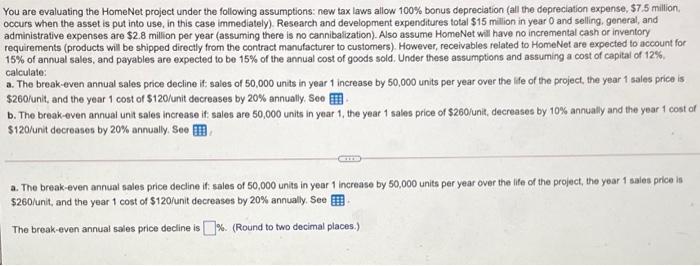You are evaluating the HomeNet project under the following assumptions: new tax laws allow 100% bonus depreciation (all the depreciation expense, $7.5 million occurs when the asset is put into use, in this case immediately). Research and development expenditures total $15 million in year and selling, general, and administrative expenses are $2.8 million per year (assuming there is no cannibalization). Also assume HomeNet will have no incremental cash or inventory requirements (products will be shipped directly from the contract manufacturer to customers). However, receivables related to HomeNot are expected to account for 15% of annual sales, and payables are expected to be 15% of the annual cost of goods sold. Under these assumptions and assuming a cost of capital of 12% calculate: a. The break-even annual sales price decline it sales of 50,000 units in year 1 increase by 50,000 units per year over the life of the project, the year 1 sales price is $260/unit, and the year 1 cost of $120/unit decreases by 20% annually. So I b. The break-even annual unit sales increase it sales are 50,000 units in year 1, the year 1 sales price of $260/unit, decreases by 10% annually and the year 1 cost of $120/unit decreases by 20% annually. See ! a. The break even annual sales price decline it sales of 50,000 units in year 1 increase by 50,000 units per year over the life of the project, the year 1 sales price is $260/unit, and the year 1 cost of $120/unit decreases by 20% annually. See The break-even annual sales prlow decline is % (Round to two decimal places.) You are evaluating the HomeNet project under the following assumptions: new tax laws allow 100% bonus depreciation (all the depreciation expense, $7.5 million occurs when the asset is put into use, in this case immediately). Research and development expenditures total $15 million in year and selling, general, and administrative expenses are $2.8 million per year (assuming there is no cannibalization). Also assume HomeNet will have no incremental cash or inventory requirements (products will be shipped directly from the contract manufacturer to customers). However, receivables related to HomeNot are expected to account for 15% of annual sales, and payables are expected to be 15% of the annual cost of goods sold. Under these assumptions and assuming a cost of capital of 12% calculate: a. The break-even annual sales price decline it sales of 50,000 units in year 1 increase by 50,000 units per year over the life of the project, the year 1 sales price is $260/unit, and the year 1 cost of $120/unit decreases by 20% annually. So I b. The break-even annual unit sales increase it sales are 50,000 units in year 1, the year 1 sales price of $260/unit, decreases by 10% annually and the year 1 cost of $120/unit decreases by 20% annually. See ! a. The break even annual sales price decline it sales of 50,000 units in year 1 increase by 50,000 units per year over the life of the project, the year 1 sales price is $260/unit, and the year 1 cost of $120/unit decreases by 20% annually. See The break-even annual sales prlow decline is % (Round to two decimal places.)







